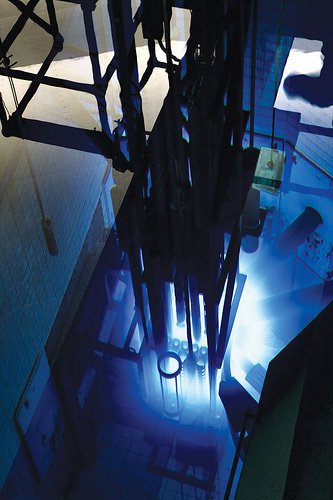The McMaster Nuclear Reactor (MNR) first became operational in 1959 and was the first university-based research reactor in the British Commonwealth. Originally designed to operate at a maximum power of 1 MW, MNR was upgraded during the 1970s to its current rating of 5 MW with a maximum thermal neutron flux of 1 x 1014 neutrons/cm2s. MNR is classified as a medium flux reactor and it is by far the most powerful research reactor at a Canadian university – the handful of so-called “Slowpoke” reactors at other institutions typically operate at a power of 0.02 MW.

The McMaster Nuclear Reactor is an open-pool type Materials Test Reactor (MTR) with a core of low enriched uranium (LEU) fuel that is moderated and cooled by light water. Primary and secondary cooling systems act to remove the heat that is generated in the core of the reactor, with external cooling towers acting as the ultimate thermal sink. The reactor is housed within a concrete containment building and generally operates weekdays from 8 a.m. until 12 midnight at a thermal power of 3 MW.

The nuclear reactor was designed with its end use as a multi-purpose research facility in mind. Its open-pool design provides ready access to the reactor core and allows for easy insertion and removal of samples for neutron irradiation, imparting a degree of flexibility that many other classes of reactors lack. As well, several beam-tubes were built into the reactor structure: today, the neutron beams extracted by these tubes are used for applications including neutron radiography and neutron diffraction experiments. MNR also has an industrial hot cell inside the reactor containment building for handling highly radioactive samples.
Staff at the McMaster Nuclear Reactor conduct hundreds of thousands of neutron irradiations every year, many in support of industry (mining exploration, environmental samples). MNR is a world leader in the production of iodine-125, a radioactive isotope that is used in the treatment of prostate cancer, with hundreds of doses produced each week. Neutrons from MNR are also used by Nray Services Inc. to conduct quality assurance testing on turbine blades for jet engines using the neutron radiography facility at one of the beam-ports. Research activities at MNR continue to expand, with a new neutron diffractometer installed in 2009 and a state of the art positron beam facility currently being designed.
McMaster Nuclear Reactor is also involved in public outreach activities such as Doors Open Hamilton, providing opportunities for McMaster students and members of the public to participate in guided tours of the reactor facility. More than 1,500 visitors each year visit MNR to lean about nuclear sciences and observe “the blue glow” of the reactor core first-hand.
